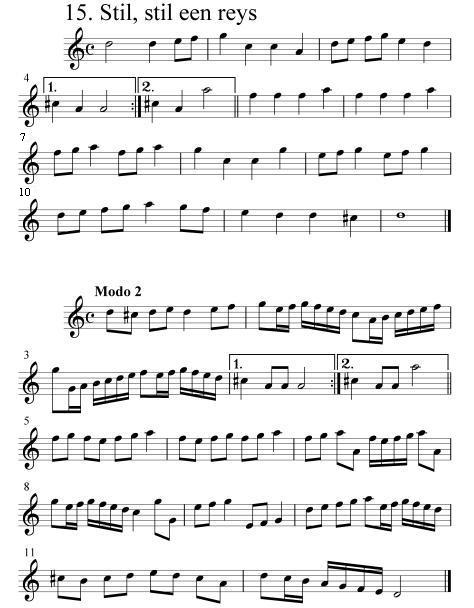|
Jacob van Eyck Quarterly 2001, No. 4 (October)
'Stil, stil een reys' : A new reconstruction Notes turned upside down, a bar shifted here and another missing there: it is generally known that the original sources of Jacob van Eyck's Der Fluyten Lust-hof are far from reliable. The composer was blind, had to dictate his music to a scribe, and could not check the printed result personally. Most of the problems can easily be solved. There is, however, one serious exception: 'Stil, stil een reys' [nve 15] from the first volume: [click on the facsimile for a better resolution] A mystery and yet one of the most beloved pieces among recorder players. Noted performers as Marion Verbruggen, Walter van Hauwe and Dan Laurin took the easy way when making a CD recording of it: they simply played the piece according to the original sources. Apparently they didn't notice that the theme is one bar shorter than its variation. And there is more wrong with it. When preparing the New Vellekoop Edition, I attempted to bring the theme and the variation in line:
Now, several years later, I feel that this reconstruction is not convincing enough. It is high time for a new solution. The theme The title given to the piece, 'Stil, stil een reys' ('Hush, hush a moment') refers to a song text by Jan Starter. It was first printed in 1616 in 't Vermaeck der Jeught by Boudewijn Jansen Wellens; five years later it was included in Starter's own Friesche Lusthof. Both publications give 'De nieuwe Laboré' ('the new Bourrée') as a tune-indication. In 1621, Starter also gave the music: [click on the facsimile for a better resolution] The original bourrée originated in France. Nicolas Vallet, in his lute collection Secret des Muses (first volume, 1615), called it 'Bouree d'avignon', as did the late 17th-century Philidor Collection. Michael Praetorius (Terpsichore, 1612) and others simply called it 'La Bourree'. The Nederlandtsche Gedenck-clanck (1626) by Adriaen Valerius gives the melody as
[For all these cognates, see Ruth van Baak Griffioen, Jacob van Eyck's Der Fluyten Lust-hof (Utrecht 1991), 333-334.] In its current version, it is a tune with a regular form schedule: two strains, the first consisting of four bars and repeated, the second consisting of eight bars. Starter's tune-indication is somewhat misleading: especially in the second strain, his version differs sharply from the 'real' bourrée. Starter stretched it by one bar. The second strain: eight or nine bars? In van Eyck's version, the second strain has eight bars in the theme and nine in the variation. Although historical evidence exists for both, as we have seen above, it goes without saying that it was never van Eyck's intention to combine them in one piece. He was very keen on variations corresponding to their themes, both formally and melodically. Van Baak Griffioen suggests that van Eyck's second strain should have nine bars, possibly prompted by the tune given in Starter's Lusthof. Van Eyck's theme, however, fully inclines to the most well-known version of the tune as given by Praetorius, Valerius and others, which implies a strain of eight bars. The problem reduced Let us first suggest that the second strain is not a complete disaster in Der Fluyten Lust-hof. In the last six bars, the variation perfectly matches the tune as it was generally known. In the theme, the first three bars of the corresponding section are shifted by a quarter note. After putting the bar lines at the right places and adding a missing quarter note g'', we can be sure of this:
This reduces the problem considerably: it is then limited to the first few bars of the second strain, where the theme has
and the variation
Here, the current version has two repeated bars, each consisting of three quarter notes f '' (or one dotted half note), followed by a quarter note a''. These two bars are preceded by an upbeat a''. Three times an a'', in other words, parted from each other by three quarter notes f ''. In Der Fluyten Lust-hof, the three notes a'' also appear, but the gaps between them are filled in different ways: 3 and 2 quarter notes in the theme, 4 and 3 (in eighth notes: 8 and 6) in the variation. For both gaps, in other words, a justification is suggested to fill it out with three quarter notes f '', in line with the current melody version. Prima and seconda volta We arrive at a point where the new solution differs fundamentally from the one I presented in the New Vellekoop Edition: a simple counting backwards leads to the evidence that the half note a'' has to be interpreted as an upbeat, and consequently as the seconda volta at the end of the first strain. We should not forget that notation practice of van Eyck's time didn't have a clear way of presenting a prima and seconda volta construction. Prima and seconda volta simply stood side by side, divided by a repeat sign. Furthermore, evidence exists that the original manuscript of Der Fluyten Lust-hof didn't contain bar-lines at all. All this could easily lead to misinterpretation by the typesetter. The addition of one quarter note f'' in the first bar of the second strain is enough to let the theme fit in with the current melody:
The variation has 10 quarters for two bars:
If we bring the quarter notes a'' in the right position, it becomes clear that the last two eighth notes (f ''-e'') should be omitted (probably the typesetter erroneously took them from the previous bar...), and that the position of the bar-line has to change:
Which other two notes should be skipped? Should we take
or
The first option is by far the most plausible. The last is less satisfying, because moving to the a'' in this early stage takes away a lot of tension. What makes the sequence f''- g'' - f'' - e'' extra convincing is that it perfectly mirrors the first half of the (corresponding) next bar, which gives f''- e''- f''- g''. The repeat sign at the end The last question to be answered is: what should we do with the repeat sign at the end of the second strain (theme and variation)? In the variation, it is impossible to link up the downward D minor scale of the last bar with the half note a'' that is needed as the upbeat of the repeated strain. As we have seen, Starter gave the melody in an A-A-B form, not A-A-B-B. Valerius gives A-A-B-B, but the text underlay makes clear that A-A-B was intended. It was a custom to print a repeat sign after the final note. Also in Der Fluyten Lust-hof, many repeat signs appear that are not intentional. We can safely assume that Jacob van Eyck had an A-A-B form in mind. A new reconstruction At the end of this 'mystery tour', we would like to present the whole piece in its new reconstruction:
[click here for listening to the MIDI file] [Click
on the icon below for a printable version
Thiemo Wind
No. 2002/1 will be available on 1 January, 2002 Do you want to receive a reminder? Send a mail: Did you reach this page through a search engine? Click below to go to the |
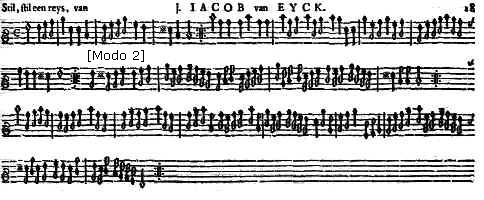
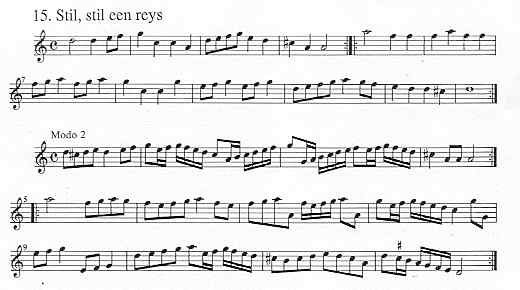

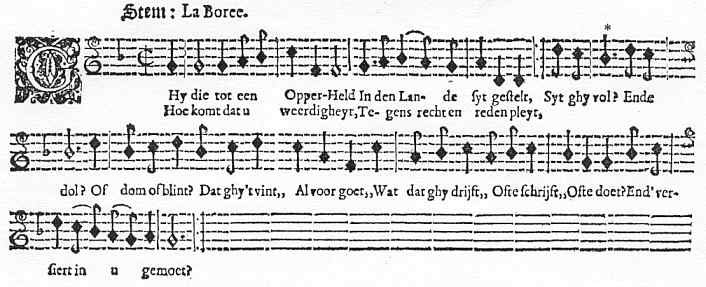
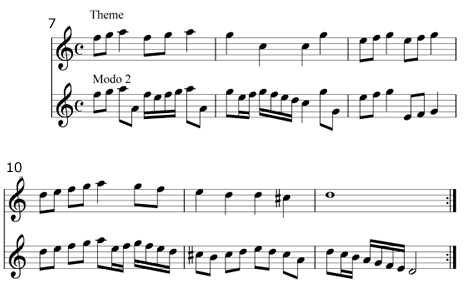
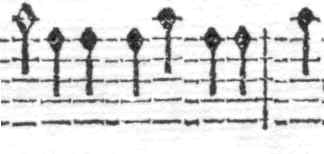





 ?
?